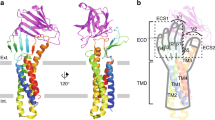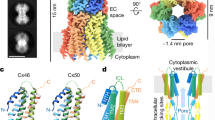Summary
The lamina fusca of the hamster eye contains layers of flattened, slightly overlapping fibroblasts. Thin sections of the overlapping margins reveal punctate, tight-junction-like membrane appositions associated with accumulation of cytoplasmic filaments, 5–7 nm in diameter. Intermediate filaments are present in the surrounding cytoplasm. A diffuse dense substance occurs in adjacent intercellular space. Freeze-fracture replicas show that the membrane appositions are mainly single-stranded tight junctions, each composed of two fibrils (micelles), and each continuous or nearly continuous around the fibroblastic perimeter. Fracturing characteristics of these junctions offer a unique opportunity to gain further insight into tight junctional morphology. When exposed, the fibrils adhere to the P-face, measure 9.2±0.3 nm in diameter, and are accompanied by a narrow band of membrane differing in texture from non-junctional membrane. Characteristically, the junctional fibrils themselves mark the deviation line along which fracture planes pass from one membrane of the junction to the other. This pattern exposes, over long distances, the P-face of one membrane on one side of this line and E-face of the adjacent membrane on the other. Analysis of any single junction over such distances reveals that the juxtaposition of the fibrils may gradually twist or undulate over a range of at least 180° within the two involved membranes. The fracture plane appears preferentially to pass between the two junctional fibrils; association of the cytoskeleton with junctional fibrils may govern this route of fracture. Cytoskeletal attachment appears to be to a single fibril and may alternate from one fibroblast to the next depending on which cytoplasmic leaflet is nearest a given fibril.
Similar content being viewed by others
References
Bartels H (1982) ‘Open’ junctions in the venular plexuses of the bronchial microcirculation. J Submicrosc Cytol 14:93–97
Bentzel CJ, Hainau B, Edelman A, Anagnostopoulos T, Benedetti EL (1976) Effect of plant cytokinins on microfilaments and tight junction permeability. Nature 264:666–668
Bentzel CJ, Hainau B, Ho S, Hui SW, Edelman A, Anagnostopoulos T, Benedetti EL (1980) Cytoplasmic regulation of tightjunction permeability. Effect of plant cytokinins. Am J Physiol 239:C75
Bulger RE (1971) Ultrastructure of the junctional complexes from the descending thin limbs of the loop of Henle from rats. Anat Rec 171:471–475
Bullivant S (1978) The structure of tight junctions. In: Sturgess JM (ed) 9th Int. Conf. Electron Microsc., Toronto, vol 3. The Imperial Press, Canada, pp 659–672
Bullivant S (1981) Possible relationships between tight junction structure and function. In: Macknight ADC, Leader JP (eds) Epithelial ion and water transport. Raven Press, New York, pp 265–275
Cereijido M, Meza I, Martinez-Palomo A (1981) Occluding junctions in cultured epithelial monolayers. Am J Physiol 240:C96-C102
Chalcroft JP, Bullivant S (1970) An interpretation of liver cell membrane and junction structure based on the observation of freeze-fracture replicas of both sides of fracture. J Cell Biol 47:49–60
Claude P (1978) Morphological factors influencing transepithelial permeability: a model for the resistance of the zonula occludens. J Membr Biol 39:219–232
Claude P, Goodenough D (1973) Fracture faces of zonulae occludentes from “tight” and “leaky” epithelia. J Cell Biol 58:390–400
Crawford BJ (1980) Development of the junctional complex during differentiation of chick pigmented epithelial cells in clonal culture. Invest Ophthalmol Vis Sci 19:223–237
Dermietzel R (1974) Junctions in the central nervous system of the cat. I. Membrane fusion in central myelin. Cell Tissue Res 148:565–576
Dym M, Fawcett DW (1970) The blood-testis barrier in the rat and the physiological compartmentation of the seminiferous epithelium. Biol Reprod 3:308–326
Easter DW, Wade JB, Boyer JL (1983) Structural integrity of hepatocyte tight junctions. J Cell Biol 96:745–749
Elias E, Hruban Z, Wade JB, Boyer JL (1980) Phalloidin-induced cholestasis: a microfilament-mediated change in junctional complex permeability. Lab Invest 77:2229–2233
Feltkamp CA, Van der Waerden AWM (1983) Junction formation between cultured normal rat hepatocytes: an ultrastructural study on the presence of cholesterol and the structure of developing tight-junction strands. J Cell Sci 63:271–286
Gilula NB, Fawcett DW, Aoki A (1976) The Sertoli cell occluding junctions and gap junctions in mature and developing mammalian testis. Dev Biol 50:142–168
Hirokawa N (1982) The intramembrane structure of tight-junctions: an experimental analysis of the single-fibril and two-fibril models using the quick-freeze method. J Ultrastruct Res 80:288–301
Hirsch M, Montcourrier P (1983) A further inconographic argument in favour of the ‘offset two-fibril’ model of the tight junction. Cell Biol Int Rep 7:406
Hirsch M, Verge D, Bouchand C, Escaig J (1980) The tight junctions of rabbit choroid plexus and ciliary body epithelia. A comparative study using the double replica freeze-fracture technique. Tissue Cell 12:437–447
Hull BE, Staehelin LA (1979) The terminal web. A reevaluation of its structure and function. J Cell Biol 81:67–82
Imhof BA, Vollmers HP, Goodman SL, Birchmeier W (1983) Cellcell interaction and polarity of epithelial cells: specific perturbation using a monoclonal antibody. Cell 35:667–675
Jamieson JD, Palade GE (1967) Intercellular transport of secretory proteins in the pancreatic exocrine cell. I. Role of the peripheral elements of the Golgi complex. J Cell Biol 34:577–596
Kachar B, Reese TS (1982) Evidence for the lipidic nature of tight junction strands. Nature 296:464–466
Karnovsky MJ (1965) A formaldehyde-glutaraldehyde fixative of high osmolality for use in electron microscopy. J Cell Biol 27:137A
Kelly DE, Hageman GS, McGregor JA (1983) Uveal compartmentalization in the hamster eye revealed by fine structural and tracer studies: implications for uveoscleral outflow. Invest Ophthalmol Vis Sci 24:1288–1304
King BF (1983) The permeability of nonhuman primate vaginal epithelium: a freeze-fracture and tracer-perfusion study. J Ultrastruct Res 83:99–110
Knutton S, Limbrick AR, Robertson JD (1978) Structure of occluding junctions in ileal epithelial cells of suckling rats. Cell Tissue Res 191:449–462
Luft JH (1961) Improvement in epoxy resin embedding methods. J Biophys Biochem Cytol 9:409–414
Madara JL (1983) Increases in guinea pig small intestinal transepithelial resistance induced by osmotic loads are accompanied by rapid alterations in absorptive-cell tight-junction structure. J Cell Biol 97:125–136
Meller K, El-Gammal S (1983) A quantitative freeze-etching study on the effects of cytochalasin B, colchicine and conconavalin A on the formation of intercellular contacts in vitro, Exp Cell Res 146:361–370
Meza I, Ibarra G, Sabanero M, Martinez-Palomo A, Cereijido M (1980) Occluding junctions and cytoskeletal components in cultured transporting epithelium. J Cell Biol 87:746–754
Mollenhauer HH (1964) Plastic embedding mixtures for use in electron microscopy. Stain Technol 39:11
Ojakian GK (1981) Tumor promotor-induced changes in the permeability of epithelial cell tight junctions. Cell 23:95–103
Orci L, Humbert F, Brown D, Perrelet A (1981) Membrane ultrastructure in urinary tubules. Int Rev Cytol 73:183–242
Orci L, Montesano R, Perrelet A (1981) Exocytosis-endocytosis as seen with morphological probes of membrane organization. Methods Cell Biol 23:283–300
Pinto da Silva P, Kachar B (1982) On tight junction structure. Cell 28:441–450
Rassat J, Robenek H, Themann H (1982) Cytochalasin B affects the gap and tight junctions of mouse hepatocytes in vivo. J Submicrosc Cytol 14:427–440
Reale E, Luciano L, Spitznas M (1975) Zonulae occludentes of the myelin lamellae in the nerve fiber layer of the retina and in the optic nerve of the rabbit: a demonstration by the freezefracture method. J Neurocytol 4:131–140
Richardson KC, Jarett L, Finke EH (1960) Embedding in epoxy resins for ultrathin sectioning in electron microscopy. Stain Technol 35:313–323
Riddle CV, Ernst SA (1979) Structural simplicity of the zonula occludens in the electrolyte secreting epithelium of the avian salt gland. J Membr Biol 45:21–35
Setoguti T, Inoue Y, Suematsu T (1982) Intercellular junctions of the hen parathyroid gland. A freeze-fracture study. J Anat 135:395–406
Shen J-Y (1984) CSF outflow pathways at the optic nerve-eye junction in the hamster. Anat Rec 208:164 A
Shen J-Y, Kelly DE, Hyman S, McComb JG (1984) Intraorbital cerebrospinal fluid outflow and the posterior uveal compartment of the hamster eye. Cell Tissue Res (in press)
Shinowara NL, Beutel WB, Revel J-P (1980) Comparative analysis of junctions in the myelin sheath of central and peripheral axons in fish, amphibians and mammals: a freeze-fracture study using complementary replicas. J Neurocytol 9:15–38
Simionescu M, Simionescu N (1977) Organization of cell junctions in the peritoneal mesothelium. J Cell Biol 74:98–110
Simionescu N, Simionescu M (1976) Galloylglucoses of low molecular weight as mordant in electron microscopy. I. Procedure, and evidence for mordanting effect. J Cell Biol 70:608–621
Simionescu M, Simionescu N, Palade GE (1976) Segmental differentiations of cell junctions in the vascular endothelium. Arteries and veins. J Cell Biol 68:705–723
Staehelin LA (1973) Further observations on the fine structure of freeze-cleaved tight junctions. J Cell Sci 13:763–786
Staehelin LA (1974) Structure and function of intercellular junctions. Int Rev Cytol 39:191–283
Tsilibary EC, Williams MC (1983) Actin in peripheral rat lung: S1 labeling and structural changes induced by cytochalasin. J Histochem Cytochem 31:1289–1297
Van Deurs B (1980) Structural aspects of brain barriers with special reference to the permeability of the cerebral endothelium and choroidal epithelium. Int Rev Cytol 65:117–191
Van Deurs B, Luft JH (1979) Effects of glutaraldehyde fixation on the structure of tight junctions. A quantitative freeze-fracture analysis. J Ultrastruct Res 68:160–172
Wade JB, Karnovsky MJ (1974) The structure of the zonula ocludens. A single fibril model based on freeze-fracture. J Cell Biol 60:168–180
Wanson JC, Drochmans P, Mosselmans R, Ronveaux MF (1977) Adult rat hepatocytes in primary culture. Ultrastructural characteristics of intercellular contacts and cell membrane differentiations. J Cell Biol 74:858–877
Author information
Authors and Affiliations
Additional information
Parts of this work have been presented at meetings of the Association for Research in Vision and Ophthalmology (Kelly and Hageman 1983) and the American Association of Anatomists (Hageman and Kelly 1984)
Rights and permissions
About this article
Cite this article
Hageman, G.S., Kelly, D.E. Fibrillar and cytoskeletal substructure of tight junctions: Analysis of single-stranded tight junctions linking fibroblasts of the lamina fusca in hamster eyes. Cell Tissue Res. 238, 545–557 (1984). https://doi.org/10.1007/BF00219871
Accepted:
Issue Date:
DOI: https://doi.org/10.1007/BF00219871




